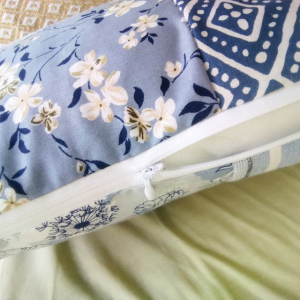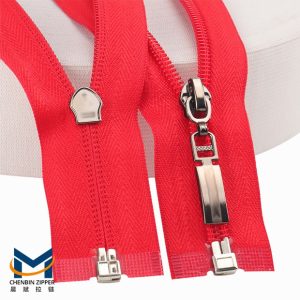Introduction to Nylon Coil Zippers
Nylon coil zippers have revolutionized the fastening industry since their invention in 1940. These versatile closures have become an integral part of our daily lives, finding their way into various applications from clothing to luggage, and even automotive interiors. In this comprehensive guide, we’ll explore the world of nylon coil zippers, their unique features, and why they’ve become the go-to choice for many manufacturers and DIY enthusiasts alike.
What Are Nylon Coil Zippers?
Nylon coil zippers, also known simply as coil zippers, are a type of zipper whose teeth or elements are made from a continuous coiled monofilament, traditionally nylon. This coil is then sewn onto a zipper tape to create the final product. The unique design of nylon coil zippers offers several advantages over other types of zippers, making them a popular choice in various industries.
Key Features of Nylon Coil Zippers
◆ Flexibility: The coiled structure allows for greater flexibility compared to metal or plastic molded zippers.
◆ Lightweight: Nylon coil zippers are significantly lighter than their metal counterparts.
◆ Durability: The continuous coil design makes these zippers resistant to separation and breakage.
◆ Smooth operation: The coil teeth provide a smooth gliding action for the slider.
◆ Water-resistance: Many nylon coil zippers offer good water-resistant properties.
◆ Variety of sizes: Available in different sizes, typically ranging from #3 to #10.
◆ Color options: Can be dyed to match or complement fabric colors.
The Anatomy of a Nylon Coil Zipper
Understanding the components of a nylon coil zipper is crucial for appreciating its functionality and choosing the right type for your project. Let’s break down the main parts:
1. Coil
The coil is the heart of the zipper, forming the interlocking teeth. Made from a continuous spiral of nylon, the coil provides the zipper’s strength and flexibility. The size of the coil determines the zipper’s strength and is typically denoted by numbers (e.g., #3, #5, #8).
2. Tape
The tape is the fabric part of the zipper to which the coil is attached. It’s usually made from polyester or nylon and can be dyed to match the coil or the fabric it will be sewn into.
3. Slider
The slider is the moving part that brings the two sides of the zipper together or separates them. It’s designed to smoothly glide along the coil, interlocking or separating the teeth as it moves.
4. Top and Bottom Stops
These are the metal or plastic pieces at the top and bottom of the zipper that prevent the slider from coming off the track.
5. Pull Tab
Attached to the slider, the pull tab is what you grasp to operate the zipper. It can come in various designs and materials to suit different aesthetic preferences.
Types of Nylon Coil Zippers
Nylon coil zippers come in various types to suit different applications. Here are some common varieties:
1. Closed-End Zippers
These zippers have a bottom stop that prevents the slider from separating at the bottom. They’re commonly used in skirts, dresses, and some types of bags.
2. Separating Zippers
Also known as open-end zippers, these can be completely separated at both ends. They’re ideal for jackets, hoodies, and other outerwear.
3. Two-Way Separating Zippers
These zippers have two sliders that can meet in the middle, allowing the zipper to be opened from both top and bottom. They’re often used in sleeping bags and long coats.
4. Continuous Zippers
Sold by the yard, these zippers allow you to cut custom lengths and add your own sliders. They’re perfect for DIY projects and custom applications.
Choosing the Right Nylon Coil Zipper
Selecting the appropriate nylon coil zipper for your project involves considering several factors:
1. Size
Zipper sizes are typically denoted by numbers, with #3 being the smallest and #10 being the largest commonly used size. The size affects the zipper’s strength and appearance.
◆ #3: Lightweight, suitable for dresses, skirts, and light jackets.
◆ #5: Medium weight, ideal for jackets, bags, and home decor items.
◆ #8 and #10: Heavy-duty, perfect for luggage, outdoor gear, and heavy coats.
2. Length
Choose a zipper length that suits your project. For garments, measure the opening where the zipper will be installed. For bags or other items, consider the desired opening size.
3. Color
Nylon coil zippers are available in a wide range of colors. You can choose a color that matches your fabric for a seamless look or opt for a contrasting color as a design feature.
4. Special Features
Consider any special requirements for your project:
◆ Water resistance for outdoor gear
◆ UV resistance for items exposed to sunlight
◆ Extra-strong coils for heavy-duty applications
Installing Nylon Coil Zippers
Installing a nylon coil zipper can be straightforward with the right technique. Here’s a basic guide:
1. Choose the correct zipper size and length for your project.
2. Pin the zipper in place, ensuring it’s centered and straight.
3. Baste the zipper in place if needed.
4. Using a zipper foot on your sewing machine, sew along both sides of the zipper tape.
5. Remove any basting stitches and give the zipper a test run.
6. It’s advisable to follow detailed tutorials or patterns for more complex installations or specific garment types.
Caring for Nylon Coil Zippers
Proper care can significantly extend the life of your nylon coil zippers:
1. Keep the coils clean and free from debris.
2. Avoid forcing the zipper if it snags; gently work it free.
3. Lubricate the zipper occasionally with a zipper lubricant or wax.
4. When washing items with nylon coil zippers, zip them up to prevent damage to the coils.
5. Avoid ironing directly over the zipper coils, as high heat can damage the nylon.
The Future of Nylon Coil Zippers
As technology advances, so do nylon coil zippers. Manufacturers are constantly innovating to improve durability, smoothness of operation, and eco-friendliness. Some exciting developments include:
1. Recycled nylon coils for more sustainable production
2. Improved water-resistant coatings for outdoor applications
3. Self-healing zippers that can realign if the coils separate
4. Smart zippers with embedded technology for various applications
Conclusion
Nylon coil zippers have come a long way since their invention in 1940. Their versatility, durability, and wide range of applications have made them an indispensable part of many industries. Whether you’re a fashion designer, outdoor enthusiast, or DIY crafter, understanding the intricacies of nylon coil zippers can help you make informed choices for your projects.
From their flexible nature to their smooth operation, nylon coil zippers offer numerous advantages over other types of fasteners. By considering factors such as size, length, color, and special features, you can select the perfect nylon coil zipper for any application.
As we look to the future, it’s clear that nylon coil zippers will continue to evolve, adapting to new technologies and environmental concerns. Their enduring popularity is a testament to their functionality and adaptability, ensuring that nylon coil zippers will remain crucial in fastening solutions for years to come.
Whether you’re zipping up a jacket, securing a tent, or closing a bag, chances are you’re using a nylon coil zipper. Their ubiquity in our daily lives is a testament to their design and functionality. As we continue to innovate and improve upon this simple yet ingenious invention, the nylon coil zipper will undoubtedly remain an integral part of our world, quietly keeping things together in more ways than one.














